
0229836_9011C_jack_koumi_designing_educational_video_and_multimedia_for_op-1
.pdf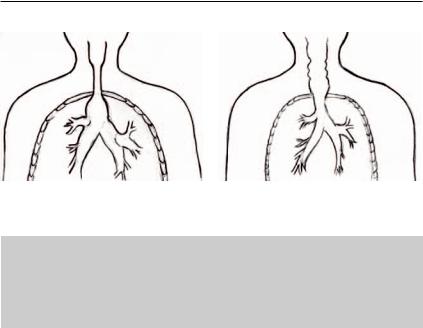
14 Techniques and teaching functions that exploit video’s strengths
(A) |
(B) |
Figure 1.9 (A) Breathing in, throat narrows, thorax widens, (B) Breathing out, throat widens, thorax narrows (LDMU)
The physiology could be explained with two diagrams and some text. However, since it is movement that is being described, video gives a fuller account and greater realism – hence is more informative, as well as being more attractive and arousing.
•singleor double-frame: in single-frame the picture changes once per frame (1 frame lasts for 1/25 of a second). In double-frame the picture changes once every two frames – this is too jerky in some situations, e.g. for a 1 sec movement across the whole screen width
•stepwise build-up of a diagram (successive segments of a diagram jump onto the screen); this technique is often used to build up a flow-chart. Strictly speaking, this is not animation, in that there is no smooth movement: additional features merely jump into an existing diagram. An example is a 30 sec clip from a video showing how axes were made in the Bronze Age (Figure 1.10). A flow-chart is built up, step by step, showing the stages in the construction process.
ÎThis clip also illustrates category 1.4, modelling, as explained later in this chapter.
Caveat: do students really learn from animations or are they merely entertained?
Viewers like animations and they say they learn from them. However, an attractive technique is a two-edged sword. Making viewers feel good (rather than bored) might stimulate learning. On the other hand they might fool themselves that they are learning just because they enjoy the animation.
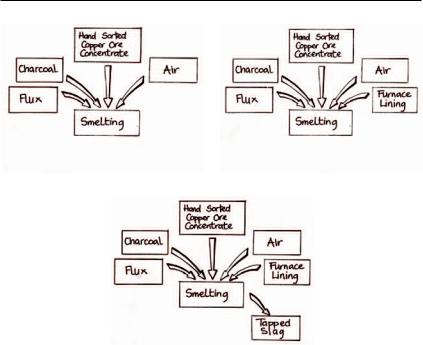
Video that adds cognitive value or skills value 15
(A) |
(B) |
(C)
Figure 1.10 (A) Construction of a bronze-age axe, (B) next stage of the construction, (C) final stage of construction (LDMU)
Certainly in the early days of the UK OU Maths output, computer animations were enjoyed by both video producers and viewers. This was despite the fact that the animations were monochrome, and hence difficult to see clearly – for example tangents of curves were difficult to distinguish from the curves. It was also despite the animations being rather fast because producers enjoyed the continuous movement and so tended not to pause the movement intermittently (and few students had replay facilities).
My minority view was that viewers were kidding themselves (as were producers). I undertook copious calculations to enable coloured animations to be done manually on cells by graphic designers. If that were not possible due to the shapes being too time-consuming to draw by hand, I would still resist monochrome computer animations of line drawings. Often, I would replace the animation by a series of stills, dissolving between them, so that the students had to imagine the in-between pictures. I still do not know how far my minority view was justified. Figure 1.11 summarizes the considerations involved in the two points of view.
This question would make an interesting research project. However, the research would not be easy, because the pedagogic quality of an animation can vary enormously. Design principles for animation are included in Chapters 5, 6 and 8.
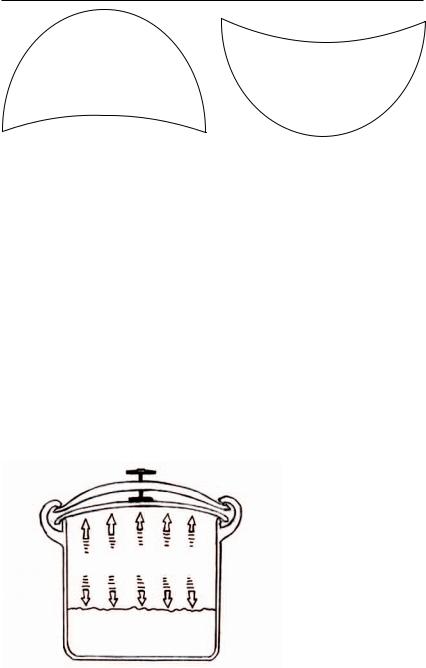
16 Techniques and teaching functions that exploit video’s strengths
On the one hand it is arrogant |
On the other hand, if you give |
and dictatorial to give them |
|
what you have decided they |
them only what they enjoy, you |
really need rather than what they |
could merely be merchandising |
merely enjoy |
your course rather than |
|
educating |
Figure 1.11 Do students learn from animations or are they merely entertained?
1 . 3 . Visual metaphor/symbolism/analogy for abstract processes
For example
•The concept of pressure inside a pressure-cooker (Figure 1.12) can be portrayed by little vibrating arrows pushing down on the liquid and pushing up on the lid.
•The concept of pressure can be symbolized by two sets of footprints in the sand, the set made by the fat man being visibly deeper than those of the thin man.
•A gravity assist, accomplished by aiming a space probe to pass close to a planet, is analogous to grabbing the hand of someone running past, in order to bend their path in a slingshot effect.
•In a crime prevention programme, Figure 1.13, viewers are warned how a car thief can seem to appear from nowhere, by showing the thief dissolving onto the scene – i.e. appearing from nowhere, like a ghost.
Figure 1.12 Pressure portrayed by vibrating arrows

Video that adds cognitive value or skills value 17
Figure 1.13 A car thief appears from nowhere
•An animation (Figure 1.14a) illustrates going back in time by removing alternate segments of a time-graph backwards, to leave a dotted graph, that is, half undrawing the graph back to a certain point (Figure 1.14b); and then adding a new graph from that point (Figure 1.14c). This technique might be
(A) |
(B) |
(C)
Intervention
Figure 1.14 (A) Original graph, (B) goiing back to an earlier time, (C) result of intervention at the earlier time
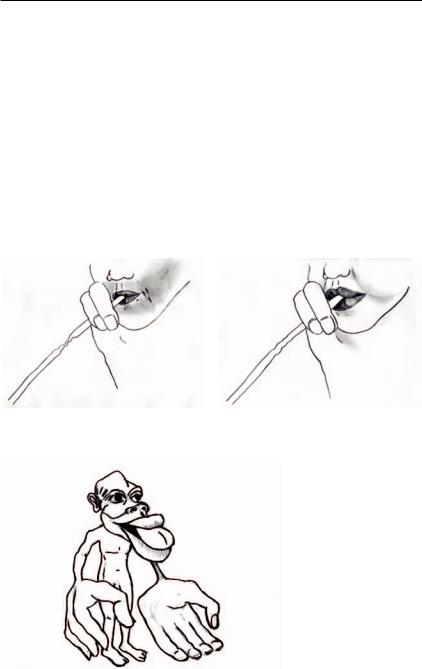
18 Techniques and teaching functions that exploit video’s strengths
used to consider an alternative progression of events, e.g. to show what the different consequence would have been if an intervention had occurred.
•In a video about change in the workplace, a shot of a snake lunging at the camera, as a metaphor for the narration change terrifies most of us.
•In a medical video (Figure 1.15a), a 17 sec clip makes an analogy with a familiar situation – a shot of a person sucking on a collapsed drinking straw could be used as an analogy for a narrowed thoracic airway causing difficulty with breathing in (the narrowed airway is due to the patient suffering from croup). The croup sufferer has no difficulty breathing out (Figure 1.15b), because during this activity the thoracic airway widens.
•Figure 1.16 illustrates a clip in a biology/psychology video about differential sensitivity in different parts of the body. The clip displays a specially built homunculus (a distorted model of a human figure), the size of whose body
(A) |
(B) |
Figure 1.15 (A) Sucking on a collapsed drinking straw: analogy for difficulty breathing in, (B) no difficulty breathing out (LDMU)
Figure 1.16 A homunculus illustrates differential sensitivity in different parts of the body

Video that adds cognitive value or skills value 19
parts correspond to their sensitivity. For example, human lips are far more sensitive than the small of the back, so the homunculus has enormous lips and a minuscule back. The figure is shown rotating.
•Aural analogies (Figure 1.17) are also possible. In a medical video, students are shown how to diagnose a pericardial friction-rub (caused by a condition in which heart tissues rub together). A 40 sec video clip demonstrates how to mimic the sound of this condition: students are shown how to hold the diaphragm of the stethoscope in the palm of their hand and then listen while they rub the back of the hand.
ÎThis clip also illustrates category 2.10, resource material, as explained in Chapter 2.
•Visual effects can constitute visual analogies, for example a page-turn transition can be an analogy for the other side of the argument (a page-turn transition is where the shot appears to turn like a page and the reverse side of the page is the next shot).
•Another visual effect that is used as a visual metaphor occurs in a 15 sec video clip. The photograph of a nuclear power station explodes. Then the photograph reconstitutes itself, as a metaphor for the implied impossibility of a nuclear explosion. These effects occur while the commentary talks about the risk of an explosion and then rejects that possibility.
•A statistics video contains a subtle example of a visual metaphor. Figure 1.18 illustrates a 10 sec clip. The narration is introducing the next topic, which is variability of data. The next shot is gradually revealed within the bars of a variable histogram. That is, the bar heights vary up and down (but more up than down, resulting in the bars eventually filling the screen). This transition between shots is a visual metaphor for the theme, variability of data.
Figure 1.17 Back hand rub: aural analogy (LDMU)
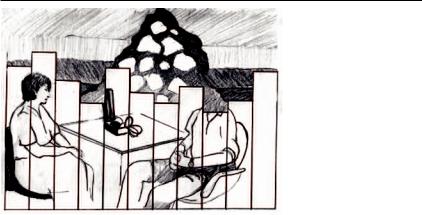
20 Techniques and teaching functions that exploit video’s strengths
Figure 1.18 Metaphor for variable data (LDMU)
This last metaphor is surreptitious, as are many, so most viewers may fail to notice them consciously. In fact there is little empirical evidence for even subconscious effects, but the industry generally accepts that these do occur – certainly makers of feature films persist in using metaphor and symbolism to create mood and are generally applauded for their style.
A further point that can be illustrated again by the last example is that metaphor is in the eye of the beholder: a beginner might not recognize the variable histogram as a metaphor for variability of data, whereas a statistician would easily recognize it.
1 . 4 . Modelling a process with a contrived, simplified version
The simplified version shows only the important features, for example:
•through dramatization for sociology (e.g. enactment of parent–teenager interaction)
•through the use of physical models, such as a giant plastic model of a neurone
•through demonstration of major steps for recombinant DNA techniques, omitting minor steps and fine detail
•similarly, a 30 sec video clip demonstrates the major steps in making a Bronze Age axe, building up a flow-chart that omits fine detail.
ÎThis clip also illustrates category 1.2, animated diagram, as illustrated earlier in Figure 1.10c.
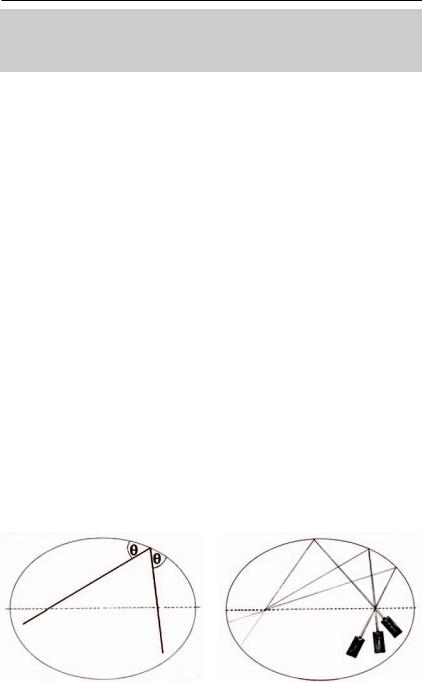
Video that adds cognitive value or skills value 21
Everything gets simplified to some extent but the modelling described here is a more purposeful simplification, as a teaching tactic.
1 . 5 . Illustrating abstract concepts with real - world examples
Evocative real-world examples (e.g. documentaries) are used to make the concepts/ principles more tangible. (There is a connection here with domain 2 of Table 0.1, the experiential domain. The presentation of real-world examples would entail experiential categories, such as 2.4, showing technical processes.) Examples of such abstract concepts include the following:
•Supply and demand – e.g. a glut of tomatoes in the street market makes their supply exceed the demand for them, driving the price down; vice versa when there is a shortage of tomatoes.
•From any point on an ellipse (Figure 1.19a), a line drawn through a focus of the ellipse makes the same angle with the ellipse as a second line from that point drawn through the second focus. This can be illustrated with a mirrored elliptic section (Figure 1.19b) by showing a beam of light through the first focus being reflected to pass through the second focus (whatever the angle of the beam).
•In a clip from a statistics video, random error and systematic error are illustrated with two contestants playing with two sets of darts. Figures 20a, 20b, 20c and 20d show the four outcomes. The white set is biased (it drifts to the right), giving a systematic error. The dark set is well balanced. Both players are aiming for the bull’s eye. One player is poor, and his set of three darts contributes additional error, called random error. (The poor player’s darts spread out much more than the good player’s.)
ÎThis clip also illustrates category 2.11, staged events, as explained in Chapter 2.
(A) |
(B) |
Figure 1.19 (A) Equal angles made by lines through each focus of an ellipse, (B) each beam of light through a focus is reflected to pass through the second focus
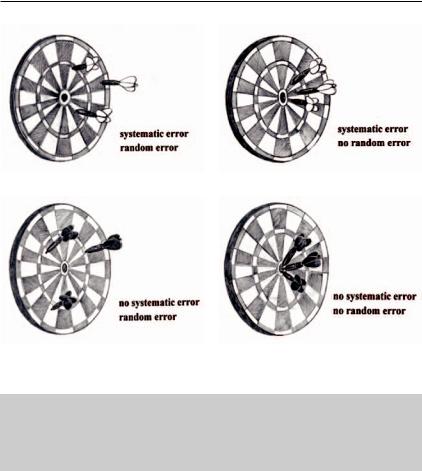
22 Techniques and teaching functions that exploit video’s strengths
(A) |
(B) |
(C) |
(D) |
Figure 1.20 (A) Biased darts, poor player, (B) biased darts, good player, (C) balanced darts, poor player, (D) balanced darts, good player (LDMU)
A multimedia package on this topic could well include considerable text, in order to present data for the learner to practice on. However, introducing video into the package enlivens it considerably
•A 20-minute video presents three real-life illustrations of the abstract concept of statistical estimation. These are, height of wheat, concentration of nickel in silver plating, heights of 7-year-old boys.
1 . 6 . Condensing time
Pruning real-world processes (e.g. editing out non-salient events) brings the duration within the viewer’s concentration span.
In an interview, the director often shoots noddies, that is, shots of the interviewer nodding, so that some of these can be interspersed in the interview. This is to allow the interview to be edited down without seeing a jump cut. For example, if you want to edit out the third paragraph of the interview, then the interviewee’s
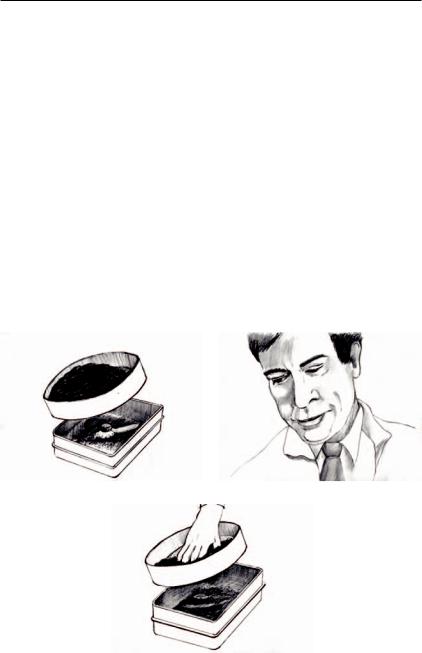
Video that adds cognitive value or skills value 23
face would usually jump sideways after the edit. To cover up such a jump cut, a common technique is to edit in a noddy at that point. Alternatively, it is now quite common to avoid noddies and instead to mix between the second paragraph and the fourth: the interviewee’s face then seems to move slowly between the two positions, rather than jumping suddenly.
Professional integrity dictates that editing a speaker should not result in misrepresentation but rather in clarification of the speaker’s meaning in the context of the whole story. (See Table 5.15 for more on professional integrity.)
If you are watching a sculptor at work with an over-the shoulder shot, you could cut to a shot of the sculptor’s eyes for a few seconds, then cut back to the sculpting but jump ahead in time, i.e. show the sculpting that happened several minutes later. You are not trying to fool the viewer that the process is quick, because this foreshortening technique is a convention that viewers understand. The cut to the man’s face is called a cut-away.
This technique is illustrated in a 17 sec video clip showing part of the process of making a Bronze Age axe. A man covers an existing axe with facing sand in order to make a mould. Figure 1.21a shows the beginning of the shot of the man’s hands sieving the sand. Figure 1.21c shows the end of the shot. A shot of the
(A) |
(B) |
(C)
Figure 1.21 (A) Axe being covered with sand: first 7 of 35 seconds, (B) cut-away of man’s face (3 seconds), (C) Final 7 seconds of the 35 second activity (LDMU)
